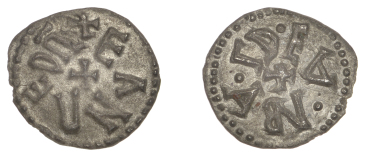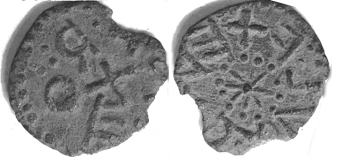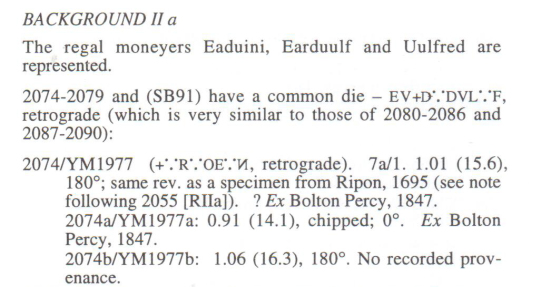Stycas Simplified
An illustrated and priced catalogue of stycas for collectors
The first edition of Sceatta List included a separate catalogue of Northumbrian stycas, amongst the simplest
of currencies. Stycas state the name of the issuer, monarch or archbishop, on the obverse and the moneyer’s name on the reverse. There are six regal issuers, three ecclesiastical and thirty-six
moneyers. The only elaboration is the repertoire of around fifty different central geometric devices. So why is the classification so opaque?
The problem arises towards the end of Eanred’s reign when there is a substantial increase in the number of moneyers in an effort to increase the volume of stycas produced. This is accompanied by a
decline in mint discipline. Dies are matched promiscuously and combinations proliferate. The output seems to be the product of a system which sets no store by the matching of moneyers with central
devices, which are used in various combinations, adding further permutations to the typology. Standards of literacy vary and both legends and individual characters appear in various scripts and
orientations.
After displaying remarkable dedication to this rather unattractive base currency, Liz Pirie built an unparalleled corpus of stycas only to spoil the effort by publishing, against the well-meant and
diplomatic advice of virtually every leading numismatist in the field at the time, a classification, in Coins of the Kingdom of Northumbria, which stifled further research for two
decades.
Rather than remaining faithful to the well-attested chronology of monarchs and moneyers, Pirie creates her “phases and groups” which take precedence over the strict chronology. The emissions of one
moneyer for a specific monarch may be catalogued in different places; different issuers appear in parallel. Huge effort is expended on accommodating the later blundered stycas in the classification
when clearly these were produced in such chaotic circumstances as to make their individual variations of negligible significance. The form in which a name is rendered (with some validity), and the
choice of central motif (more dubiously), are regarded as primary criteria of classification. Had this resulted in an elegant and accessible arrangement, then much could be forgiven. However, the
outcome is impenetrable. To locate a single sub-variety demands far too great an investment of time in headache-inducing, eye-straining concentration necessitating inconvenient comparison of images
across numerous pages.
Is there a better methodology? How does Tony Abramson overcome this obstacle? For the casual enquirer, there is a much-simplified approach. However, it does involve one heretical step, at which the
purist may recoil. One must divorce the obverse and reverse and consider issuers and moneyers separately rather than in combination. By this means, and by largely ignoring the proliferation of
central motifs, the entire corpus suddenly falls into a neat, accessible arrangement facilitating both identification and structured collecting.
This heresy may prevent the methodology from providing a basis for reclassification and, in any event, this is not the intention. Abramson is simply attempting to lift the veil - to bring stycas back
out of the shadows and cast some light on their easier identification.
Stycas Simplified catalogues the main varieties separately for the two groups of issuers – each of the monarchs and archbishops – and for each of the moneyers. There is a listing of central
motifs and a scarcity analysis. Again, market pricing is discussed and prices are provided for fine and very fine grades.
In Abramson's opinion, the first, silver-alloy, issues of Eanred and Archbishop Eanbald II, were clearly an attempt to revive the early-penny. It is only with the
second issue, towards the end of Eanred's reign, that the coins lose all precious metal content. For this reason the first issue is now included as tertiary Northumbrian sceats in
Sceatta List, ed. II.
40pp, p/b © Tony Abramson, 2012. Production: Charlesworth Press.
Sceatta List (first ed.) and Stycas Simplified are in one volume.
Some additional styca varities and improved images are listed below:
John N. Cross's 2021 bequest of early/Anglo-Saxon coins to the British Numismatic Society, was a remarkably generous gesture. His collection contained many iconic and desirable coins of the highest rarity, such as the uninscribed,'architectural' variety of the York gold shilling, whose reverse undoubtedly shows the new minster planned by King Edwin and completed by Osbald.
Illustration above: 02-27, rare ODILO MON styca for Eanred. Ex John Cross, Canterbury Auction Galleries, 3rd October 2021, lot 540-8. Courtesy JNC.
The styca on the front of Styca Supplement is shown at B-05 below.
Cast lead-embedded styca weight of Aethelred II, probably moneyer Eardwulf.
PAS LVPL-5E4310, 16.5g
The very fine condition indicates use of a pristine coin and little subsequent use as a weight. See also PAS records LIN-3DFD27 YORYM-8054B2. Similar examples can be found on p19, Biggs and Withers, (2000).
Image courtesy of Glenn Lister, May 2023.
5-25S, a ‘special motif’ styca of Aethelred II, first reign (841-843/4) by the moneyer Leofthegn, ‘swastika’ obverse.
Obverse: +AEDELREDREX, Aethelred II, around ‘swastika’ in circle, special motif S4.
Reverse: +LEOFDEGN, Leofthegn, around pellet in beaded circle, motif 5a.
Vestigial beaded borders.
Found December 2023, near Rillington, East Yorkshire.
Image courtesy of Carl Newson.
I-12, a new m/d find of the irregular issue of moneyer Eadwulf, Pirie 2074, showing a fine example of central motif 7a. See extract of Pirie's CKN below. Pirie gives the motifs as 7a/1, but they are in fact 1/7d. Motif 7d is shown in the graphic on page 8 of her Catalogue of the Early Northumbrian Coins in the Museum of Antiquities, Newcastle-Upon-Tyne and appears on coins 439-441 in that work. This graphic is more comprehensive than in her later, seminal, Coins of the Kingdom of Northumbria.
Found near Northallerton, NY.
Image courtesy of Patrick Goodall, April 2023.










